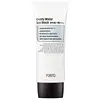What's inside
What's inside
 Key Ingredients
Key Ingredients

 Benefits
Benefits

 Concerns
Concerns

 Ingredients Side-by-side
Ingredients Side-by-side

Vinyl Dimethicone/Methicone Silsesquioxane Crosspolymer
Synthetic Wax
AbrasiveOctocrylene
UV AbsorberDiethylhexyl Carbonate
EmollientSilica
AbrasiveEthylhexyl Methoxycinnamate
UV AbsorberC12-15 Alkyl Benzoate
AntimicrobialDiethylamino Hydroxybenzoyl Hexyl Benzoate
UV FilterButylene Glycol Dicaprylate/Dicaprate
EmollientEthylhexyl Salicylate
UV AbsorberDipropylene Glycol
HumectantPhenyl Trimethicone
Skin ConditioningBis-Ethylhexyloxyphenol Methoxyphenyl Triazine
Skin ConditioningMicrocrystalline Wax
Emulsion Stabilising1,2-Hexanediol
Skin ConditioningSorbitan Sesquioleate
EmulsifyingCaprylic/Capric Glycerides
EmollientCetyl Alcohol
EmollientParfum
MaskingDiisostearyl Malate
EmollientGlycyrrhiza Glabra Root Extract
BleachingNiacinamide
SmoothingAdenosine
Skin ConditioningPentylene Glycol
Skin ConditioningBlue 1 Lake
Cosmetic ColorantVinyl Dimethicone/Methicone Silsesquioxane Crosspolymer, Synthetic Wax, Octocrylene, Diethylhexyl Carbonate, Silica, Ethylhexyl Methoxycinnamate, C12-15 Alkyl Benzoate, Diethylamino Hydroxybenzoyl Hexyl Benzoate, Butylene Glycol Dicaprylate/Dicaprate, Ethylhexyl Salicylate, Dipropylene Glycol, Phenyl Trimethicone, Bis-Ethylhexyloxyphenol Methoxyphenyl Triazine, Microcrystalline Wax, 1,2-Hexanediol, Sorbitan Sesquioleate, Caprylic/Capric Glycerides, Cetyl Alcohol, Parfum, Diisostearyl Malate, Glycyrrhiza Glabra Root Extract, Niacinamide, Adenosine, Pentylene Glycol, Blue 1 Lake
Water
Skin ConditioningCetyl Ethylhexanoate
EmollientButylene Glycol
HumectantGlycerin
HumectantDipropylene Glycol
HumectantZinc Oxide
Cosmetic ColorantSilica
AbrasiveNiacinamide
Smoothing1,2-Hexanediol
Skin ConditioningPolyglyceryl-3 Methylglucose Distearate
EmulsifyingCI 77891
Cosmetic ColorantSodium Polyacryloyldimethyl Taurate
Emulsion StabilisingCetearyl Olivate
Sorbitan Olivate
EmulsifyingStearic Acid
CleansingMadecassoside
AntioxidantAsiaticoside
AntioxidantMadecassic Acid
Skin ConditioningAsiatic Acid
Skin ConditioningLauroyl Lysine
Skin ConditioningDisodium EDTA
Acrylates/C10-30 Alkyl Acrylate Crosspolymer
Emulsion StabilisingAdenosine
Skin ConditioningHydroxyethyl Acrylate/Sodium Acryloyldimethyl Taurate Copolymer
Emulsion StabilisingWater, Cetyl Ethylhexanoate, Butylene Glycol, Glycerin, Dipropylene Glycol, Zinc Oxide, Silica, Niacinamide, 1,2-Hexanediol, Polyglyceryl-3 Methylglucose Distearate, CI 77891, Sodium Polyacryloyldimethyl Taurate, Cetearyl Olivate, Sorbitan Olivate, Stearic Acid, Madecassoside, Asiaticoside, Madecassic Acid, Asiatic Acid, Lauroyl Lysine, Disodium EDTA, Acrylates/C10-30 Alkyl Acrylate Crosspolymer, Adenosine, Hydroxyethyl Acrylate/Sodium Acryloyldimethyl Taurate Copolymer
Ingredients Explained
These ingredients are found in both products.
Ingredients higher up in an ingredient list are typically present in a larger amount.
1,2-Hexanediol is a synthetic liquid and another multi-functional powerhouse.
It is a:
- Humectant, drawing moisture into the skin
- Emollient, helping to soften skin
- Solvent, dispersing and stabilizing formulas
- Preservative booster, enhancing the antimicrobial activity of other preservatives
Adenosine is in every living organism. It is one of four components in nucleic acids that helps store our DNA.
Adenosine has many benefits when used. These benefits include hydrating the skin, smoothing skin, and reducing wrinkles. Once applied, adenosine increases collagen production. It also helps with improving firmness and tissue repair.
Studies have found adenosine may also help with wound healing.
In skincare products, Adenosine is usually derived from yeast.
Learn more about AdenosineDipropylene Glycol is a synthetically created humectant, stabilizer, and solvent.
This ingredient helps:
Dipropylene glycol is technically an alcohol, but it belongs to the glycol family (often considered part of the ‘good’ alcohols). This means it is hydrating and gentle on skin unlike drying solvent alcohols like denatured alcohol.
As a masking agent, Dipropylene Glycol can be used to cover the smell of other ingredients. However, it does not have a scent.
Studies show Dipropylene Glycol is considered safe to use in skincare.
Learn more about Dipropylene GlycolNiacinamide is a multitasking form of vitamin B3 that strengthens the skin barrier, reduces pores and dark spots, regulates oil, and improves signs of aging.
And the best part? It's gentle and well-tolerated by most skin types, including sensitive and reactive skin.
You might have heard of "niacin flush", or the reddening of skin that causes itchiness. Niacinamide has not been found to cause this.
In very rare cases, some individuals may not be able to tolerate niacinamide at all or experience an allergic reaction to it.
If you are experiencing flaking, irritation, and dryness with this ingredient, be sure to double check all your products as this ingredient can be found in all categories of skincare.
When incorporating niacinamide into your routine, look out for concentration amounts. Typically, 5% niacinamide provides benefits such as fading dark spots. However, if you have sensitive skin, it is better to begin with a smaller concentration.
When you apply niacinamide to your skin, your body converts it into nicotinamide adenine dinucleotide (NAD). NAD is an essential coenzyme that is already found in your cells as "fuel" and powers countless biological processes.
In your skin, NAD helps repair cell damage, produce new healthy cells, support collagen production, strengthen the skin barrier, and fight environmental stressors (like UV and pollution).
Our natural NAD levels start to decline with age, leading to slower skin repair, visible aging, and a weaker skin barrier. By providing your skin niacinamide, you're recharging your skin's NAD levels. This leads to stronger, healthier, and younger looking skin.
Another name for vitamin B3 is nicotinamide. This vitamin is water-soluble and our bodies don't store it. We obtain Vitamin B3 from either food or skincare. Meat, fish, wheat, yeast, and leafy greens contain vitamin B3.
The type of niacinamide used in skincare is synthetically created.
Learn more about NiacinamideSilica, also known as silicon dioxide, is a naturally occurring mineral. It is used as a fine, spherical, and porous powder in cosmetics.
Though it has exfoliant properties, the function of silica varies depending on the product.
The unique structure of silica enhances the spreadability and adds smoothness, making it a great texture enhancer.
It is also used as an active carrier, emulsifier, and mattifier due to its ability to absorb excess oil.
In some products, tiny microneedles called spicules are made from silica or hydrolyzed sponge. When you rub them in, they lightly polish away dead skin layers and enhance the penetration of active ingredients.
Learn more about Silica